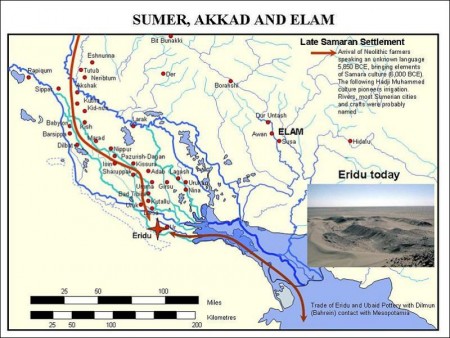Sumer (or Šumer) was one of the early civilizations of the Ancient Near East, located in the southern part of Mesopotamia (southeastern Iraq) from the time of the earliest records in the mid-fourth millennium B.C.E. until the rise of Babylonia in the late third millennium B.C.E. The term “Sumerian” applies to all speakers of the Sumerian language. Sumer together with Ancient Egypt and the Indus Valley Civilization is considered the first settled society in the world to have manifested all the features needed to qualify fully as a “civilization.”
The development of the City State as an organized social and political settlement enabled art and commerce, writing and architectures, including the building of Temples (ziggurats) to flourish. The history of Sumeria dates back to the beginning of writing and also of law, which the Sumerian are credited with inventing. and was essential for maintaining order within the City-States.
City-States for centuries used variations of Sumerian Law, which established set penalties for particular offenses. This represents recognition that societies can not function without respect for life and property and shared values. More and more people became aware of belonging to the same world as a result of Sumeria’s contribution to the human story. Treaties from Sumeria indicate a preference for trade and commerce.
The term “Sumerian” is an exonym first applied by the Akkadians. The Sumerians called themselves “the black-headed people” (sag-gi-ga) and their land “land of the civilized lords” (ki-en-gir). The Akkadian word Shumer may represent this name in dialect, but we actually do not know why the Akkadians called the southern land Shumeru. Biblical Shinar, Egyptian Sngr and Hittite Šanhar(a) could be western variants of Šumer.
The Sumerians were a non-Semitic people and were at one time believed to have been invaders, as a number of linguists believed they could detect a substrate language beneath Sumerian. However, the archaeological record shows clear uninterrupted cultural continuity from the time of the Early Ubaid period (5200-4500 B.C.E. C-14, 6090-5429 B.C.E. calBC) settlements in southern Mesopotamia. The Sumerian people who settled here farmed the lands in this region that were made fertile by silt deposited by the Tigris and the Euphrates rivers.
The challenge for any population attempting to dwell in Iraq’s arid southern floodplain, where rainfall is currently less than 5 inches a year, was to manage the Tigris and Euphrates rivers to supply year-round water for farming and drinking. The Sumerian language has many terms for canals, dikes, and reservoirs. Sumerian speakers were farmers who moved down from the north after perfecting irrigation agriculture there.
The Ubaid pottery of southern Mesopotamia has been connected via Choga Mami Transitional ware to the pottery of the Samarra period culture (c. 5700-4900 B.C.E. C-14, 6640-5816 B.C.E. in the north, who were the first to practice a primitive form of irrigation agriculture along the middle Tigris River and its tributaries.
The connection is most clearly seen at Tell Awayli (Oueilli, Oueili) near Larsa, excavated by the French in the 1980s, where 8 levels yielded pre-Ubaid pottery resembling Samarran ware. Farming peoples spread down into southern Mesopotamia because they had developed a temple-centered social organization for mobilizing labor and technology for water control, enabling them to survive and prosper in a difficult environment.
Visits: 254



